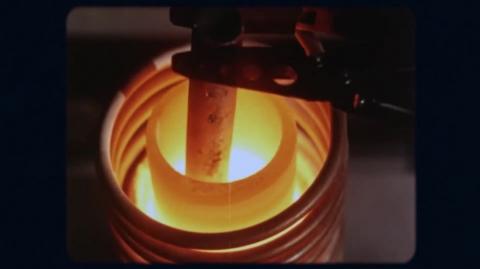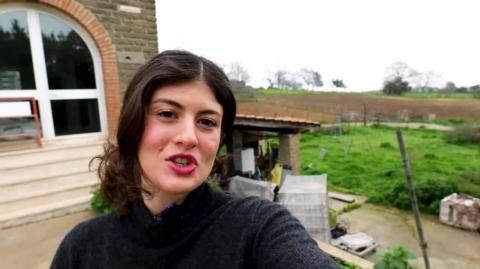Ancient Egyptian Granite Sawing Technology: reconstruction
The experimentalist Nikolay Vasiutin attempts to cut a piece of granite using ancient Egyptian methods: utilizing a copper saw with an abrasive agent (corundum). The stone cutting experiment was conducted for antropogenez.ru portal.
Granite, a Copper Saw, and Abrasive Material Principles of Loose Abrasive Sawing.
Excellent article by Oleg Kruglyakov: https://antropogenez.ru/sawing/
Subscribe to our channel: https://clck.ru/Jnmvo
Eager for more experiments? Become a Patron: https://www.patreon.com/bePatron?c=1927495
Specifications:
- Copper strip length: 22 cm
- Granite piece thickness: 17 mm
- Cut Length: 48 cm
- Cut Width (max): ~6mm
- Total time taken: 3.5 hours
- Extracted granite weight: 46g (3012-2966=46)
- Granite volume: 17,03 cm3
- Copper material wear: 23 gr. (229-206=23)
- Copper volume: 2.58 cm3
Participants:
- Nikolay Vasiutin
- Aleksandr Sokolov (editor of ANTROPOGENEZ.RU)
- Valeriy Senmuth @Валерий Senmuth
- Oleg Krugliakov
- Yekaterina Shutova
- Video Recording and editing: Vladimir Morozov @ http://Spezinform.ru
- Translation and voiceover: Eduard Trofimov
The original premier took place on 10.06.17 @ Moscow, as a part of "Scientists against Myths 4" educational forum.
(С) ANTROPOGENEZ.RU with support of "Polniy P" Studio http://oper.ru/
http://www.facebook.com/antropogenez
https://vk.com/antropogenez_ru
Contact: g_souris@mail.ru
Skype: ya-kudzo
0



 Life_N_Times_of_Shane_T_Hanson
Life_N_Times_of_Shane_T_Hanson

 Redacted News
Redacted News

 The Alex Jones Show
The Alex Jones Show



 KEEPER
KEEPER


 Amiba
Amiba



 RT
RT

 Styxhexenhammer666
Styxhexenhammer666
 Hammerhand
Hammerhand

Log in to comment
I had a great awakening - about a week or two back - it's not that I didn't know it, I just never put the pieces together on this issue.
OK on a bicycle 10 + speed racer / mountain bike / hybrid etc., well a STEEL drive set, composed of a steel front gear set, a steel chain, and a steel rear gear cluster, will for the nit picky and perfectionist, will wear out more or less as a set and need to be replaced as a set.
BUT if you have the big front cogs made from aluminium and a steel chain and a rear steel gear cluster, then the aluminium front sprockets will outlast about 3 sets of chains and rear clusters for a magical reason.
The grit from the roads is composed of sandy silicates (quartz = silicon dioxide and aluminium dioxide = saphire), and these are very hard abrasives.
So these dusts, grits and muds, blow in on the wind and throw up from the wheels, and land on the chain and sprockets.
With the non stick lubricants they land on and sort of go around and then get thrown off, with a little oil, they stick in the oil and make grinding paste, and go round and round and round...
No matter.
The point is that the steel rubs and grinds away, and with the big front aluminium sprockets, the aluminium is softer and the grit gets pressed into the surface of the aluminium, the grit cuts away at the chain and it's rollers - and so that is why the aluminium front gears outlast about 3 chains and rear gear clusters...
The aluminium with it's embedded grit, grinds up the chain and the grit in the sprocket surface, also helps to protect the sprocket from more abrasion by the free grit landing on it from the wheels and chain.....
So it occurred to me the other day, that using copper tools to cut and drill hard and soft stones, that copper is in fact an excellent choice - give or take some considerations....
While copper is soft - compared to all steels - like stone cutting saw steels - with and without carbide and diamond teeth.
But while diamond is very hard and many of the silicate other oxides are also very hard, most of them are not that far off diamond hardness... while hammered copper is about as hard as it will ever get...
But the copper will pit and take the stone dust and grit into it's surface and these will grind away at the stone the copper tool is grinding into.
I have no idea of the ratio of copper used up, to the amount of stone ground out, for the different stone types, from experience and by measurement, but people have figured out that copper stone working tools - in combination with a variety of other stone working tools, is a pretty good and valuable material to have in the mix.
So that is the train of thought have just linked to copper stone working tools...
Just off the top of my head, I estimate that 1 Kg of copper abrasion blade, could remove 20 to 50 Kg of stone - even more.... I don't know - but properly set up - it will work a lot better than a bad set up.
It's like a rotary saw - low speed, modestly high pressure, a water trickle feed, and very small backwards and forwards movements to keep the grit embedded into it's surface, like 1/2 a millimeter and then periodic lifting to wash the wet dust out and to allow some hard grit in, and then back into the cut and the copper tool face.
I like copper as a material - very much - but it's a cunt to machine / drill and tap threads into - got to be all specially set up with rigid tooling, the optimum tool profies and the correct lubricants for copper....
Other wise it grabs and binds and welds drills and taps and lathe tools....
Fucking unbelievable.
It's like a very hard, but slightly gummy toffee that you get on toffee apples.....